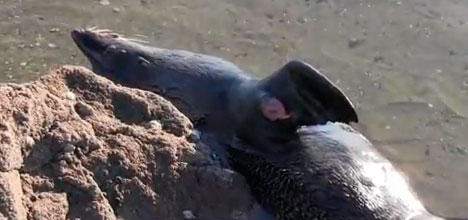The injured seal that's been hanging about the Waimarino and the Kulim Avenue waterfront this week is just looking for somewhere to rest up.
DOC Ranger Pete Huggins says the injury to its flipper is not a significant injury.
'It looks pretty nasty, but it's certainly not life-threatening. Obviously we feel for the seal, but it's trying to do its natural thing - to get up out of the water and rest. Hopefully it will find somewhere a bit better soon.
'This one is probably looking for somewhere to chill out, but unfortunately it keeps coming up against people. It will sooner or later find somewhere it can just relax.
'If it came up anywhere east of Omanu, people are quite used to seeing seals there and people would avoid it, and it would have a day or so rest.”
The seal is probably a yearling that has swum all the way from the South Island to enjoy the Bay of Plenty's balmy winter. They arrive tired from the long swim and are just looking for somewhere to rest up.
'The ones that go on the beach just end up sitting on the beach for a day, they are just knackered basically,” says Pete.
Seals are going to become a more common sight in Tauranga as the population recovers from the near extinction brought about by European fur sealers. They have been protected since 1978, and have a population estimated at about 60,000. Before the European arrival the population was estimated at two million.
'Their numbers are slowly increasing, there are lots more breeding down south and as the breeding down south increases they are coming further and further up in greater numbers,” says Pete.
'For Tauranga residents who have probably grown up around here and never seen seals, this is going to be every year, and potentially more and more, and we know they are breeding now on offshore islands from Tauranga.
'So it could be a resident population. It's really neat because this is what makes New Zealand such an attractive place to come to, because we have all this wildlife.”
As seals are going to become a more common sight he wants the public reaction to be more nuanced.
'We'll keep an eye on this particular one because people are concerned about its well-being,” says Pete.
He wants people to call DOC if a seal is being harassed by dogs or humans or has a life-threatening injury.
'We want people to get that seeing seals is normal. It's a seal, if it looks fine keep going.”
Inhabiting fresh water like that found near the Waimarino Centre on the Waitroa River is considered normal seal behaviour.
'They do go up into the fresh water,” says Pete.
'They often get ticks and parasites at sea and the fresh water can help clean them. Also there are nice fresh water fish up there.”
At sea the New Zealand fur seal feeds on squid, octopus, lantern fish and school fish. They feed mainly at night and can stay underwater for ten minutes and dive deeper than 100m.



0 comments
Leave a Comment
You must be logged in to make a comment.